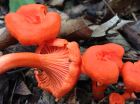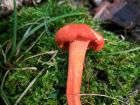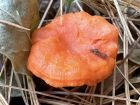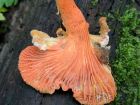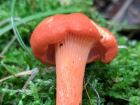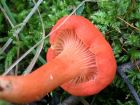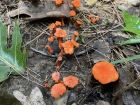Cap starts convex, broadening as it ages, eventually becoming flat or shallowly depressed at the centre. Initially, the margin curls inward, later expanding and developing waviness. Colour ranges from flamingo pink to cinnabar red, with hues of pinkish-orange or reddish-orange. The mushroom has gill-like veins under the cap that run down the stem, not gills. Flesh whitish or tinged with the cap color; not changing color when sliced. Stem solid, equal when young but by maturity usually tapers downward from the cap. It is coloured like the cap or paler. Spore print whitish or slightly pinkish.
Microscopic Features: Spores measure 6-8 x 3.5-5 µ and are ellipsoid, sometimes showing constriction. They have a smooth surface, are inamyloid, and appear ochraceous in KOH. Their contents are finely granular.
Cantharellus cinnabarinus on the MushroomExpert.Com Web site.
The first photo is by dario.z and licensed under the Creative Commons Attribution-ShareAlike 3.0 Unported license.
Many mushrooms are poisonous, and some can be lethally toxic. Distinguishing between edible and poisonous mushrooms can be very challenging. Therefore, we strongly advise against consuming wild mushrooms. This website does not contain any information about the edibility or toxicity of mushrooms.
Although efforts have been made to ensure accuracy on this website, the information may contain errors and omissions. Therefore, all content provided is for educational and informational purposes only and should not be relied upon or used as a basis for consuming any plants or mushrooms.
External links are provided for reference only. We do not endorse or take responsibility for the content, advice, or products found on these sites or in any advertisements shown on this website.
